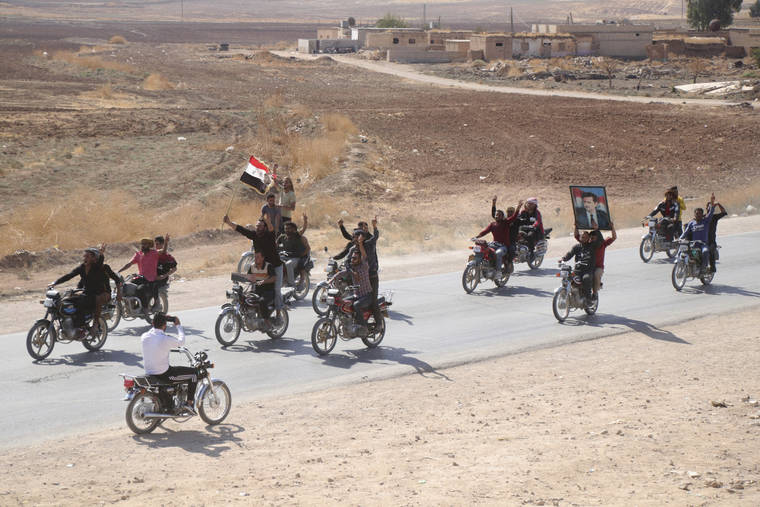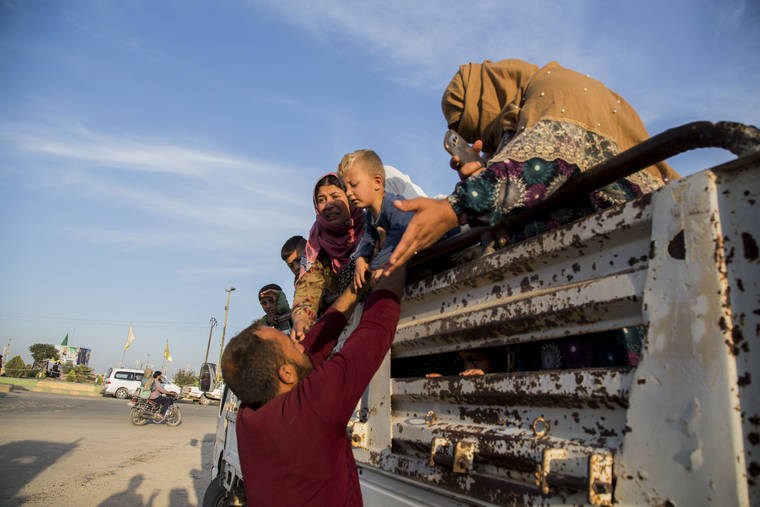AKCAKALE, Turkey — Syrian government troops moved into towns and villages in northeastern Syria on Monday, including the flashpoint region of Manbij, setting up a potential clash with Turkish-led forces advancing in the area as long-standing alliances in the region began to shift or crumble following the pullback of U.S. forces.
The Syrian military’s deployment near the Turkish border came after Syrian Kurdish forces previously allied with the U.S. said they had reached a deal with President Bashar Assad’s government to help them fend off Turkey’s invasion, now in its sixth day.
Assad’s return to the region his troops abandoned in 2012 at the height of the Syrian civil war is a turning point in Syria’s eight-year civil war, giving yet another major boost to his government and its Russian backers and is like to endanger, if not altogether crush, the brief experiment in self-rule set up by Syria’s Kurds since the conflict began.
The rapidly changing situation was set in motion last week, when U.S. President Donald Trump ordered American troops in northern Syria to step aside, clearing the way for an attack by Turkey, which regards the Kurdish fighters as terrorists. Since 2014, the Kurds have fought alongside the U.S. in defeating the Islamic State in Syria, and Trump’s move was decried at home and abroad as a betrayal of an ally.
Faced with unrelenting criticism, Trump said Monday he was putting new sanctions on Turkey, halting trade negotiations and raising steel tariffs in an effort to pressure Ankara to stop its offensive.
In the past five days, Turkish troops and their allies have pushed into northern towns and villages, clashing with the Kurdish fighters over a stretch of 200 kilometers (125 miles). The offensive has displaced at least 130,000 people.
“Where is the United Nations? Let them come see the blood of our children on the floor! Why don’t they show up?” cried a medic at the Tal Tamr hospital, which received dozens of injured people from nearby Turkish shelling in recent days.
Abandoned in the middle of the battlefield, the Kurds turned to Assad and Russia for protection and announced Sunday night that Syrian government troops would be deployed in Kurdish-controlled towns and villages along the border to help repel the Turkish advance.
Kurdish official Aldar Khalil said in a statement that the aim of the agreement is for Syrian troops to be deployed along the border, except for the area between the towns of Ras al-Ayn and Tal Abyad, where Turkish troops are advancing. He added that the autonomous authority will continue to run daily affairs in northeast Syria.
“There is an understanding between SDF and Damascus — a military agreement only,” said Badran Ciya Kurd, a senior Kurdish official, referring to the Kurdish-led Syrian Democratic Forces. He has been in talks with Russians since the start, and he made his comments in an interview with The Associated Press.
Syrian state media broadcast repeated footage of government forces entering northern towns and villages with residents chanting slogans in support of Assad, while others rushed to hug the soldiers. In a northern village, residents welcomed the troops by showering them with rice, an Arab gesture of welcome. In another village, dozens of young men rode motorcycles as some waved posters of Assad.
“We are going back to our normal positions that are at the border,” said a Syrian officer, as embattled Kurdish authorities invited the government to retake towns and villages in the north.
“May God protect the army!” residents responded.
The dramatic events are a crushing blow to the dreams of Syria’s Kurds who had built up a degree of autonomy that was unthinkable before the war, when they were an oppressed minority by the Assad family rule. The ethnic group grew from an underdog in Syria to a prestigious group that controls about 30 percent of Syrian territory, working hand in hand with the Americans to defeat the Islamic State group.
A return by Assad’s forces to their region is a major shift in Syria’s long-running civil war, further cementing Assad’s hold over the ravaged country.
The Syrian troops arrived in the northern province of Raqqa aboard buses and pickup trucks with mounted machine guns. Troops moved into the towns of Tal Tamr, about 20 kilometers (12 miles) from the Turkish border, Ein Issa and Tabqa, known for its dam on the Euphrates River and a nearby air base of the same name.
They later entered the Kurdish-held town of Manbij, in a race with Turkey-backed opposition fighters advancing in the same direction. The Manbij region is home to U.S. outposts that were set up in 2017 to patrol the tense frontiers between Turkish-controlled areas and the Kurdish-held side of northern Syria. A U.S. official said troops are still in the town, preparing to leave.
Earlier, Syrian fighters backed by Turkey said they began an offensive alongside Turkish troops to capture Manbij, which is on the western flank of the Euphrates River, broadening their campaign east of the river. Mustafa Sejari, an official with the Turkey-backed fighters, tweeted: “The battle of Manbij has begun.”
Turkey’s private NTV television reported that Turkish special forces and commandos began advancing toward Manbij in the afternoon. CNN-Turk also mentioned the attack, reporting that the sound of clashes could be heard.
Turkish President Recep Tayyip Erdogan signaled earlier in the day his military was ready to begin the assault Manbij, with a goal of returning the city to Arab populations that he said were its rightful owners.
Speaking later in Baku, Azerbaijan, Erdogan said Turkey’s military offensive into northeast Syria is as “vital” to Turkey as its 1974 military intervention in Cyprus, which split the island. Erdogan also made clear Turkey would not halt its offensive despite the widespread condemnation.
The military action by Ankara sets up a potential clash between Turkey and Syria and raises the specter of a resurgent Islamic State group as the U.S. relinquishes any remaining influence in northern Syria to Assad and his chief backer, Russia.
Turkey warned its NATO allies in Europe and the United States not to stand in its way.
Trump said the roughly 1,000 U.S. troops he ordered out of Syria would remain in the Middle East to prevent a resurgence of the IS threat.
The European Union unanimously condemned Turkey’s military move and asked all 28 of its member states to stop selling arms to Ankara, Spanish Foreign Minister Josep Borrell told the AP.
In Moscow, Kremlin spokesman Dmitry Peskov told reporters that Russian and Turkish officials have remained in close contact. Russia appeared to be working on de-confliction between Turkish and Syrian troops.
Erdogan has already said Turkey will not negotiate with the Syrian Kurdish fighters, saying they have links to a long-running Kurdish insurgency within its own borders.
Syria’s state-run news agency SANA said government forces planned to “confront the Turkish aggression,” without giving further details.
Photos posted by SANA showed several vehicles and a small number of troops in Tal Tamr, a predominantly Assyrian Christian town that was once held by IS before it was retaken by Kurdish-led forces. Many Syrian Christians, who make up about 10 percent of Syria’s prewar population of 23 million, left for Europe in the past 20 years, with the flight gathering speed since the conflict began in March 2011.
Heavy fighting on Sunday reached a Kurdish-run camp for displaced persons in Ein Issa. The camp is home to about 12,000 people, including around 950 wives and children of IS fighters, and hundreds are believed to have escaped amid the chaos.
————
Mroue reported from Beirut. Associated Press writers Albert Aji in Damascus, Syria, and Suzan Fraser in Ankara, Turkey, contributed.



